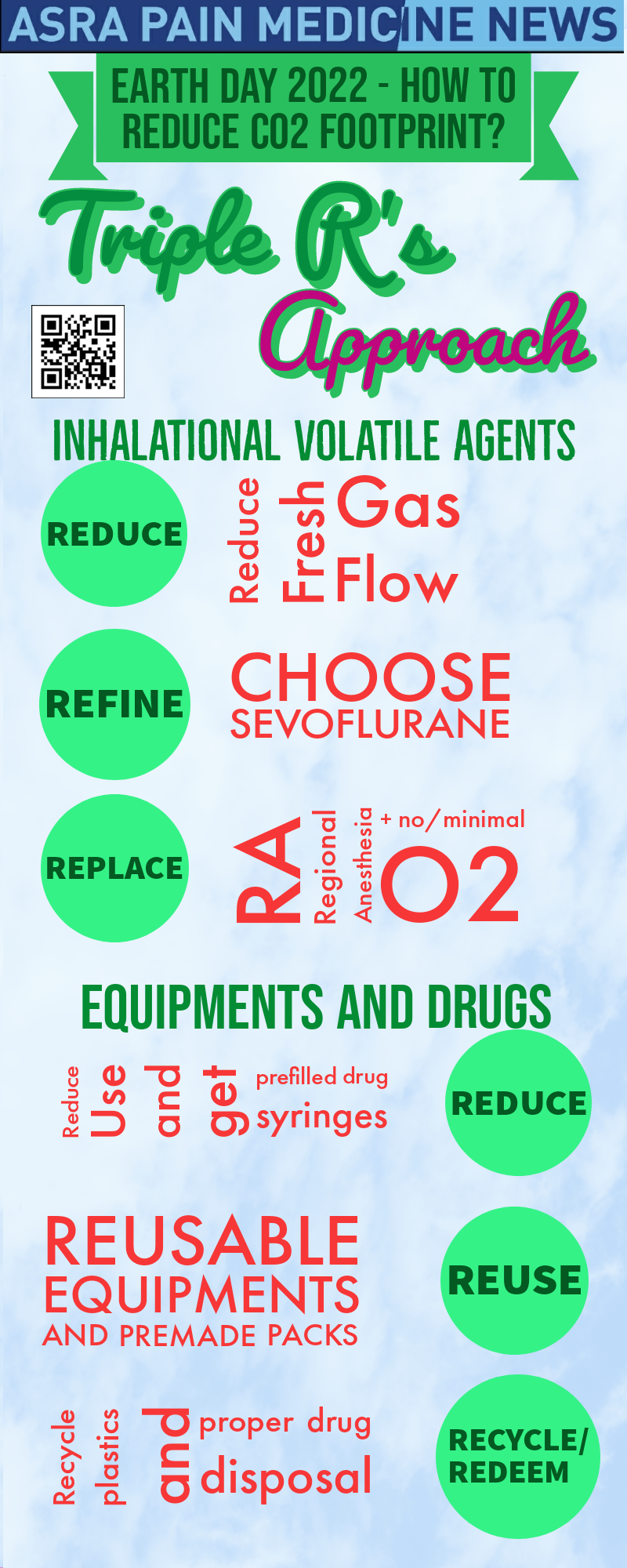Earth Day 2022 – How to Reduce the C02 Footprint from our Anesthetic Practice
Cite as: Ip VHY, Sondekoppam RV, Ozelsel TJP. Earth Day 2022 – how to reduce the C02 footprint from our anesthetic practice. ASRA Pain Medicine News 2022;47. https://doi.org/10.52211/asra050122.026
ASRA Pain Medicine News seeks to bring you new materials and styles of presentation. As such we will now include infographics regarding a submitted or published article. An infographic should be accompanied by a short summary explaining the infographic that you have created. The following is our first infographic published in the ASRA Pain Medicine newsletter, and I hope you enjoy reading it. We welcome your submissions. Please send them to [email protected].
Urgent action is required to reduce carbon dioxide emission in light of the recent Intergovernmental Panel on Climate Change (IPCC) Sixth Assessment Report. The Report warns that if global warming is not limited to 1.5°C in the near term, the impacts of climate change are expected to intensify rapidly by mid-century. 1 As anesthesiologists, we are responsible for tons of carbon dioxide emissions whenever we provide anesthetic.2 It is never too late to reflect on our anesthetic practice and to adapt a more environmentally sustainable approach without compromising patient care.
For this year’s Earth Day, we participated in increasing the awareness of the ‘green’ practice in anesthesia with an infographic (Figure 1). This infographic provides an easy reference to remind us of the salient points in practicing environmentally sustainable anesthetic. We outline the triple R’s approach to reduce inhalational volatile agents: reduce their use by minimizing fresh gas flow, refine them by choosing a volatile agent with much less carbon dioxide emission, such as sevoflurane, and replace volatile anesthetics with regional anesthetics using no or minimal oxygen.3 The latter is also helpful because supplemental oxygen during sedation can be a major source of carbon dioxide emission due to energy requirement for liquid oxygen compression.4 In addition, if no or minimal sedation is used to accompany the regional or neuraxial anesthesia, the amount of oxygen should not be higher than 4Lmin-1.
When preparing for the anesthetic, we should be cognizant of using only necessary equipment and drugs. Pre-filled syringes can be adopted to reduce drug wastage, for example, phenylephrine and atropine. Reusable equipment should be the device of choice whenever possible, and premade packs such as neuraxial or central line packs can reduce the amount of plastic wastage from packaging. Finally, plastics and paper should be recycled, and proper disposal of drugs should be adopted, especially drugs with high persistency, toxicity or bioaccumulation indeces, such as propofol.


Vivian H.Y. Ip, MBChB, FRCA, is an associate clinical professor in the department of Anesthesiology and Pain Medicine at the University of Alberta Hospital in Edmonton, Canada.

Rakesh V. Sondekoppam, MBBS, MD, is an associate professor in the department of Anesthesia at the University of Iowa Carver College of Medicine in Iowa City.

Timur J.P. Özelsel, MD, DESA, is a clinical professor in the department of Anesthesiology and Pain Medicine at the University of Alberta Hospital in Edmonton, Canada.
References
- The Intergovernmental Panel on Climate Change. IPCC Sixth Assessment Report; Fact Sheets. Available at https://www.ipcc.ch/report/ar6/wg2/about/factsheets/. Accessed April 15, 2022.
- Vollmer M, Rhee T, Rigby M, et al. Modern inhalation anesthetix: potent greenhouse gases in the global atmosphere. Geophys Res Lett 2015;42:1606-11. https://doi.org/10.1002/2014GL062785
- Ozelsel T.J.P, Sondekoppam RV, Ip V.H.V, Tsui B.C.H. Re-defining the 3R’s (reduce, refine, and replace) of sustainability to minimize the environmental impact of inhalational anesthetic agents. Can J Anaesth 2019;66(3):249-54. https://doi.org/10.1007/s12630-018-01279-3
- McGain F, Sheridan N, Wickramarachchi K, et al. Carbon footprint of general, regional, and combined anesthesia for total knee replacements. Anesthesiology. 2021;135:976-91. https://doi.org/10.1097/ALN.0000000000003967
Leave a commentOrder by
Newest on top Oldest on top